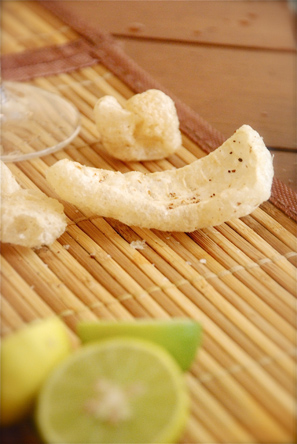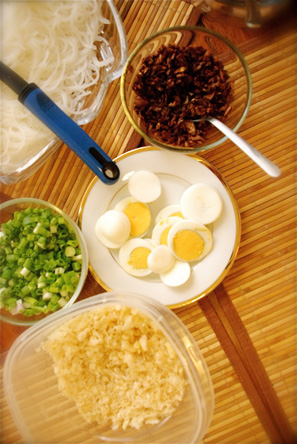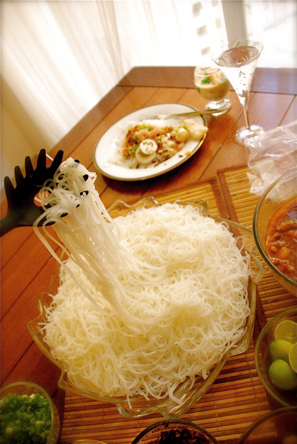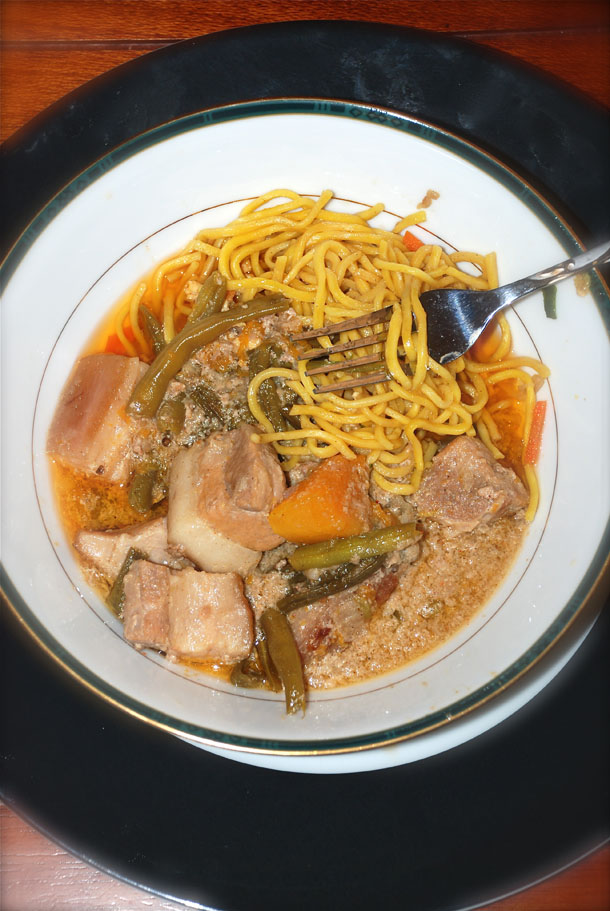
Ultimately I’m taking a breather from Bengali cuisine. It’s been long that I have been writing only on Bengali food juxtaposed against living in Dubai. This is but very natural since we come from Bengal. There’s a lot of experiments on Bengali cuisine in our kitchen – Bong food and non-Bong food – both traditional and fusion. There is also another type of cuisine that is cooked on a fairly regular basis and that is Filipino food. Courtesy, my Lady Friday (LF) who hails from Bicol. Located in the southernmost tip of Luzon Island, the largest island in the Philippine archipelago, Bicol or Bikol is known for it’s spicy cuisine. Bikol has had a history of trade relations with the Malay-Indonesian kingdoms, India and Arabia. So cuisine here is enriched with their influences, even resulting in a Biriyani dish!

An earlier post dwells upon a fusion dish that we both created – Rasgulla Macapuno which has also been aired on local TV channel. It’s a tribute to LF without whom my endless photographic sessions on food experiments would never have materialised. She’s also been a mother to Li’l Z, having missed out on bringing up her own kids as she has been busy working far away from home to earn the money that is required to bring her own children up. It is estimated that between 9.5 million to 12.5 million Filipinos work or reside abroad, many taking up jobs that they haven’t been doing back in their country. So while LF had been working as a cashier in Manila, here she looks after our home and our children. She’s working as a maid – a term I detest totally. And I do hope that we are being able to give her the respect that she feels that she had earned while she was working as a cashier.
On a tangential note, if staying with a person from a different culture for a long time doesn’t inspire us, we must be devoid of all emotional sensibilities. The real essence of living in a city like Dubai is that for a Filipina who’s turned into a Bong, there is also a Bengali ME who’s turned into a Filipina!
◊—————————————————————◊
Over a few episodes in my Filipino food trail, I shall venture upon a few dishes that LF cooks regularly for us. There are also many restaurants in Dubai where we generally get our fix of Filipino fare! Contrary to popular belief, Filipino Cuisine can be elaborate and the cooking process has greatly been influenced by the countries it has had trade relationship with, namely Malay, Indian, Arab, Chinese, Spanish, Japanese, American and other Asian and Latin countries. An elaborate read on Filipino Cuisine can be found here.
Pancit/Noodles – Palabok, Bihon, Canton
Pancit or Pansit is the term for Noodles in Filipino cuisine. In-fact, in Philippines you’ll find Panciterias or shops specializing only in noodles. The following points are interesting:
– There are around 30 variations of Pancit that are available!
– Noodles were introduced into the Philippines by the Chinese and have since been adopted into the Filipino local cuisine. Other Chinese influences in Filipino cooking is Toyo/Soy sauce; Tokwa/tofu; Tawge/Bean sprout and Patis/Fish sauce as well as the method of stir frying and making thick soup bases
– According to Chinese food lore handed down, noodles should be eaten on one’s birthday. Since noodles represent long life and good health; they must not be cut short! Chinese restaurants in the Philippines often have birthday noodles as part of their special menus
– There’s no time for eating Pancit or Rice for that matter. It could be had for breakfast, lunch, dinner, snacks and even in between
– It can be had by mixing only Pancit and Rice together with some left over dish or simply with dried fish pickle
◊—————————————————————◊
Pancit Palabok
Category – Main Meal; Cuisine type – Filipino
Recipe contains Pork and Beef but that can be easily substituted with Lamb and Chicken
Following are the characteristics of all recipes doling out of our little hands, big hearth –
♥ Easy to cook
♥ Regular canned products off the shelf may be used (However, we advocate using fresh products)
♥ Goes well both as a regular or party dish
♥ Children can easily help in making the dish (My two little sous-chéfs are aged 8 and 3 years!)
♥ And lastly, guaranteed to be tasty!



Pancit Palabok and Pancit Luglug are more or less the same. In the latter thicker noodles are used than the traditional Palabok (above). This is a very popular communal comfort food and why should it not be? When you slurp up a fork twisting in some thin white Rice vermicelli noodles dripping with meat sauce and shriek as a few drop of the sauce splatters on your clothes, you’ll realise the comfort that surrounds you for sure.
Pancit Palabok is more like the Burmese Khauk swè thohk – wheat noodle salad with dried shrimps, cabbage and carrots, garnished with fried peanut oil, fish sauce, fried onions, garlic and lime. You are supposed to vary these everytime you serve yourself and the taste completely varies. The Pancit is served first then the thick meat sauce or broth and then the various garnishes – fried shrimp, shrimp sauce, fried garlic, boiled pork, hard-boiled egg (sliced into smaller pieces), fresh green spring onions (chopped), Tinapa (smoked fish flakes) and Chicharon (crushed pork crackling, shown in the above left picture). The Chicharon looks like Prawn chips and we have sprinkled these over for friends who do not eat pork. Not the same smell though! Squeeze a lot of lime and the Pancit Palabok is ready to be slurped up. The entire Pancit Palabok entourage is shown below!








Serves 6-8 persons
Preparation time – 1 hr maximum (Boiling the Pancit – 10 minutes; Preparing the Broth – 30 minutes; preparing the other garnishes – 15 minutes)
Ingredients
Special Palabok Noodles – 1 pack (it’s written in the pack. You may have Bihon type of Rice Noodles which are really thin or the Pancit Luglug where the strands of Rice Vermicelli are relatively thicker than the Bihon type)
For the Meat Sauce or the Broth
Onions – 2 big, finely chopped
Garlic – 5 pods, crushed
Patis/Fish Sauce – 2tbsp
Beef or Pork – 200gm. minced and pounded
Shrimps – 100 gm, shelled, deveined and cut into small pieces
Black Pepper – 1/2 tsp, grounded
Salt – as per taste
Achuete or Annatto Seeds – 2 tbsp, pre-soaked in 1/4 cup water for a few minutes to give the bright orange colour (Annatto is safe for most people when used in food amounts; however, it can cause rare allergic reactions for those who are sensitive. Read more)
All purpose Flour or Corn Starch – 3 tbsp, dissolved in 1/4 cup water
White Oil – 2tbsp
Garnishing or Toppings
Boiled Pork – 100 gms, thinly sliced
Tinapa/smoked Tuna flakes – 2-3 pieces smoked Fish, cooked, deboned and flaked
Tokwa/Tofu – 8 pieces, fried and cubed
Chicharon – 1 cup, crushed
Eggs – 3, hard-boiled and sliced
Spring Onions – 1/2 cup, chopped finely
Shrimps – 1 cup, boiled and chopped
Garlic – 10 pods, sliced and fried crisply
Calamansi/Lime – 6 pieces*
*Calamansi is a kind of Lime available in all Filipino kitchens and is perhaps the secret ingredient to many mouthwatering Filipino delicacies – from popular desserts like Leche Flan to adding that magic sour flavour to Pancit Palabok and other Filipino dishes)
Method of Preparation
Pancit
– Boil the Palabok/rice noodles for 3-4 minutes. Drain the water and set aside.(The noodles should be soft but not soggy)
The Broth
– Heat White oil in a wok
– Fry the Onions and Garlic till they are brown
– Add the Patis/Fish Sauce, mince meat, ground Black Pepper, Salt
– Add 2 cups of boiled water, cover the wok with a lid and let the Broth simmer for a while in low seam
– Add the soaked Annatto and let the Broth boil till the Mince Meat is done
– Add the boiled Shrimps at the last
– Add the Corn starch and let the broth thicken by boiling for 5 more minutes
How do we serve Palabok?
Serve Pancit on a plate, pour the Mince Meat Broth over it, sprinkle Tinapa flakes, crushed Chicharon, Tokwa pieces, fried garlic, boiled Eggs, boiled Shrimps and freshly chopped Spring Onions. Squeeze Calamansi or Lime generously. This is our favourite of all Pancits that LF has been cooking at home.


◊—————————————————————◊
Pancit Bihon
Category – Main Meal; Cuisine type – Filipino
Contains Pork and Beef. But can be easily substituted with Lamb, Chicken or Shrimps
Pancit bihon are very thin rice noodles. It’s accompanied by fried meat slices, chopped fresh vegetables, Soy Sauce, Patis/Fish Sauce and definitely Chinese sausage and cabbage.
Serves 6-8 persons
Preparation time – 45 minutes maximum (Boiling the Pancit – 10 minutes; Preparing the Meat and vegetables – 30 minutes)
Ingredients
Special Bihon Noodles – 1 pack
For the Meat & Vegetables
Onions – 2 big, finely chopped
Garlic – 5 pods, crushed
Patis/Fish Sauce – 2tbsp
Beef or Pork – 200gm. stripped into thin pieces
Carrots – 2, sliced into thin strips
French Beans – Sliced angularly
Cabbage – 1 small, julienned
Toyo/Soy Sauce – 3 tbsp
Black Pepper – 1/2 tsp, grounded
Salt – as per taste
White Oil – 2tbsp
Method of Preparation
Pancit
– Boil the Pancit Bihon/rice noodles for 3-4 minutes. Drain the water and set aside.(The noodles should be soft but not soggy)
The Meat & Vegetables
– Heat White oil in a wok
– Fry the Onions and Garlic till they are brown
– Add the Patis/Fish Sauce, Meat strips, ground Black Pepper, Salt
– Add 1/2 cup of boiled water, cover the wok with a lid and let the meat simmer for a while in low seam
– Add the chopped Carrots, Cabbage and French beans and let them cook for a while (the vegetables should be cooked but not turn soggy and soft)
– Mix the Meat and the Vegetables to the Pancit
◊—————————————————————◊
Pancit Canton
Category – Main Meal; Cuisine type – Filipino
Contains Pork and Beef. But can be easily substituted with Lamb, Chicken or Shrimps. Note: This is a spicy dish

Pancit Canton are thick flour noodles. This dish closely resembles the Chinese Chow Mein. But LF sometimes cooks another favourite dish of ours called Bikol Express (Mixed Seafood Bikol Expresscoming up definitely in a detailed future post).
Serves 6-8 persons
Preparation time – 45 minutes maximum (Boiling the Pancit – 10 minutes; Preparing the Bikol Express – 30 minutes)
Ingredients
Pancit Canton Noodles – 1 pack
Bikol Express
Onions – 2 big, finely chopped
Garlic – 5 pods, crushed
Coconut Milk – 1 can
Pork belly – 500gms, cubed
String Beans – 200gms, chopped into long slices
Pumpkin – small, cubed
Black Pepper – 1/2 tsp, grounded
Long Thai Green Chilli or Serrano Pepper – 6, cut into long slices
Shrimp Paste – 1/2 cup
Salt – as per taste
White Oil – 2tbsp
Method of Preparation
Pancit
– Boil the Pancit Canton/rice noodles for 3-4 minutes. Drain the water and set aside.(The noodles should be soft but not soggy)
The Meat & Vegetables
– Heat White oil in a wok
– Fry the Onions and Garlic till they are brown
– Add the Coconut Milk, Pork cubes, ground Black Pepper, Salt, Long Green Chillies, Shrimp Paste and stir fry
– Cover the wok with a lid and let the meat simmer for a while in low seam
– Add the chopped String Beans, Pumpkin Cubes and let them cook for a while (the vegetables should be cooked but not turn soggy and soft)
– Mix the Bikol Express to the Pancit
◊—————————————————————◊

Thanks to LF we have been introduced to the brilliant gastronomical world of Filipino Cuisine. She has also learnt how to cook Bengali food and has become quite a pro at it. She’s become a part of our family. Gulf News, the leading newspaper in this region featured a blog, True life story of Filipina Maid in Dubai, which is quite an interesting take -off on the Filipino diaspora residing in Dubai and resonates the lives and moments of thousands of thousands of maids employed in the UAE. Working for a couple with two school-going children, Sally describes the daily details of looking after children, cleaning house, stealing time to catch up on gossip with neighbouring maids, the joys of computer-educating herself, her pangs of homesickness, her best friend Lilibeth and her devious plans to make money, all with a generous dose of humour, some of it dark, and some outright tears-in-your-eyes moments.
Don’t judge the English or the grammar. It’s a reflection into our inner minds as well!
Unblogging it all… Ishita
Disclaimer: I hope you enjoy reading the posts with lot of visuals. While you enjoy seeing them please don’t use them. You can see more pictures of my travel and food journey here.


Sounds awesome! Will our Seviya work as well?
LikeLike
Madhu this is exactly what I’ve been thinking but you know what? Vermicelli Noodles are very commonly used in Italian cooking. So why not? These are very readily available in Asian and normal supermarkets even. So have never tried Vermicelli!
LikeLike
Perhaps the south Indian rice vermicelli would work better.
LikeLike
I think so too. All I can say is that we drool over the Pancit Palabok!
LikeLike
My Filipina blogger friend replied – ‘Unfortunately I haven’t seen what Indian Rice Vermicelli look like. Noodles use for palabok is much thicker in than vermicelli but I’ve once use our vermicelli for palabok so I think you can. if your vermicelli looks like the one we use for bihon then its’ ok to use as substitute’
LikeLike
Thank you Ishita for embracing Filipino food and introducing it to your family and friends. Palabok is my favorite while my boys prefer canton. Pancit is always present on our tables on special occasions mostly on birthdays as it means wising the celebrant long life.
LikeLike
Abigail – thanks for the feedback. And also the queries on Fia group. We are very fond of Palabok.
LikeLike
Visually Pancit Bihon looks more appealing to me probably because of the vibrant orange of the carrot and my weakness for loads of veggies in the non-veg dish. I must try all, as they all look appetizing and simple to make. A ‘one-dish’ that will satisfy all 🙂 Thanks for sharing
LikeLike
Yes, but Pancit Palabok has a very interesting twist – have you ever tasted the Burmese Khauk swè thohk? Where you keep on varying the garnishes each time you serve yourself and the taste completely changes. Try kore dekho – bhishon easy aar amazingly tasty. Do let me know:)
LikeLike
This dish looks wonderful and I completely agree with you about how those who help up in the house become like family and we learn so much from them. Years ago (I was an expat kid) we had a filipino lady who worked for us in Brunei. At home she was a school teacher with eight children. It makes me sad that she made more to send home to her family as a maid than she could make teaching school in her home country. Her mother was raising her children. Sad realities of life. You honor your Lady Friday with your post.
LikeLike
Thank you so much Stacy. And yes, then you do understand the sentiment. I’ve done a small film too tagging her along for Dubai One and Noor Dubai (Rasgulla Macapuno On TV & Shubho Bijoya to all – the last post in the Recent posts segment) where we’ve done a fusion BEngali sweet with Filipino Macapuno. Actually my blog pretty much started this way – fusion Bengali food but on the way I started re-discovering much of traditional and heritage Bengali food and other cuisine that I needed to share… Thanks for hopping in, my new Fia Food chum!
LikeLike
Until now I still refuse to make these dishes! It’s a long process!!!
LikeLike
But at the end of it awaits a very delicious food. It’s worth the process:)
LikeLike
lovely post…Dubai Sally is actually an expat’s wife… brilliant humorous way of blogging though… grammatical errors were intentional and it leaves me in stitches 🙂
LikeLike
Thank you Nina – a big compliment coming from the ‘real’ source. What are you saying that it’s an expat wife? Even Gulf News has covered it. I simply love it. I go into splits:)
LikeLike
I was wondering, from an academic point of view, how seemingly simple elements cook up to make amazingly different things. I mean from the same ingredients we make/can make so many things which are entirely different. 🙂
Trying this on coming tuesday 🙂
LikeLike
So true… the other day I attended a cooking demo of Chef Sam Clark and his wife of Moro fame. They cooked two tagines – one fish, one chicken – same Indian spices – coriander, turmeric, cumin, chillies and loads of coriander leaves – the taste was different belonging to an entirely different cuisine type – Moroccan.
LikeLike
Pingback: Bikol Express & The Romanticism Of The Mayon Volcano «
Palabok at Jollibee, Philippines. Jollibee is like McDonald’s, haha. It’s more fun in the Philippines. 😀
LikeLike
Try Panicit Luglog also known as Pancit Malabon matching our very own Halo-Halo in RAZON RESTAURANT. The restaurant started in Pampanga, Philippines. The cooking capital of the philippines. That was the best Halo-Halo I have ever tated. Halo-Halo is a dessert that compliments with Pancit Luglog (Pancit malabon). I just hope Razon Restaurant could make a stall in Dubai. It’s really a great thing specially on summer.
LikeLike
I’ve tasted Halo-Halo – one of my favourites. I’ve found fab Halo halo here in Chow King and Max Restaurant on Trade Centre Road. Also Golden Fork has a lot of Filipino food in their menu. Do you have any suggestions for a good Filipino Restaurant in Dubai?
LikeLike
Try to visit NOW CAFE in Dubai Mall. It recently opened this year. 🙂
LikeLike
Pingback: Ruen Mai Restaurant In Krabi | Tantalising Experience Of Thai Food In Thailand! |
Pingback: Koh Klang in Krabi, Thailand | A Photo Essay of The Local Village Life |
Pingback: Baan Ma-Yhing Restaurant In The Fishermen’s Village | Cooking Freshly Caught Baramundi In Thai Red Curry! |
Pingback: {New Post} Kotung Restaurant in Krabi Town | A Taste of Thai Chinese |
Pingback: Kayaking, Caves, Krabi Sightseeing… And Finally A Thai Spa! |
Pingback: Hong Island… Where I Finally Met God! |
Pingback: Payesh or Rice Pudding For My Birthday | Power of Gratitude Messages | IshitaUnblogged
Pingback: ChefXChange | When A Chef Comes Home | IshitaUnblogged
Pingback: Moong Daaler Payesh or Yellow Lentil Pudding | Autumnal Sunshine Of The Eternal Mind! | IshitaUnblogged
Pingback: Shubho Noboborsho | A traditional Bengali menu for Frying Pan Diaries podcast